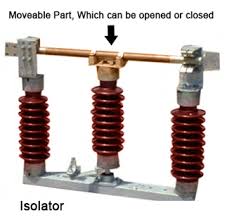Isolator
1)Isolator (disconnecting switch) operate under no load condition. It does not have any specified current breaking capacity or current making capacity Isolator is not even used for breaking load current. In some cases, isolators are used for breaking charging current of transmission lines

2)Circuit breaker can make and break electric circuit under normal current or short-circuit conditions Isolators are used in addition to circuit breakers. While opening a circuit, the circuit breaker is opened first, then isolator. While closing a circuit, the isolator is closed first, then circuit-breaker
3)Isolators are necessary on supply side of circuit-breakers in order to ensure isolation (disconnection) of the circuit breaker from live parts for the purpose of maintenance Isolators used in power-system are generally 3-pole isolator.
4)The three pole isolators have three identical poles. Each pole consists of two or three insulators posts mounted on a fabricated support. The conducting parts are supported on the insulator posts.
5)The conducting parts consists of conducting copper or aluminium rod, fixed and moving contacts. During the opening operation, the conducting rod swings apart and isolation is obtained.
6)The simultaneous operation of three poles is obtained by mechanical interlocking of the three poles. Further, for all the three poles, there is a common operating mechanism.
The operating mechanism is manual plus one of the following:
(1)Electrical motor mechanism.
(2)Pneumatic mechanism The customer selects the operating mechanism suitable to him, Further , the isolator can be provided with the earthing switch when required. The earthing switch. consists of conductor bar. When the earthing switch is to be closed, these bars swing and connect the contact on line unit of isolator to earth




